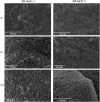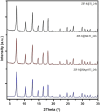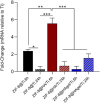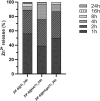Porous titanium scaffolds modified with Zeolitic Imidazolate Framework (ZIF-8) with enhanced osteogenic activity for the prevention of implant-associated infections
- PMID: 39268004
- PMCID: PMC11390653
- DOI: 10.3389/fchem.2024.1452670
Porous titanium scaffolds modified with Zeolitic Imidazolate Framework (ZIF-8) with enhanced osteogenic activity for the prevention of implant-associated infections
Abstract
In this study, zeolitic imidazolate framework 8 (ZIF-8) was coated on porous Ti6Al4V scaffolds, either bare or previously modified using hydroxyapatite (HA) or HA and gelatin (HAgel), via a growing single-step method in aqueous media using two contact times at 6 h and 24 h. The coated scaffolds termed ZIF-8@Ti, ZIF-8@HA/Ti, and ZIF-8@HAgel/Ti were characterized via scanning electron microscopy (SEM), powder X-ray diffraction (PXRD), attenuated total reflectance-Fourier transform infrared (ATR-FTIR), and molecular plasma-atomic emission spectroscopy (MP-AES). In order to assess the cell proliferation rate, the cytocompatibility of the scaffolds was evaluated in primary osteoblasts (hOBs) using alamarBlue assay, while the osteoconductivity was analyzed in hOBs using a real-time approach, evaluating the expression of secreted phosphoprotein 1 (SPP1). Osteopontin, which is the protein encoded by this gene, represents the major non-collagenous bone protein that binds tightly to HA. The scaffolds were shown to be non-cytotoxic based on hOB proliferation at all time points of analysis (24 h and 72 h). In hOB cultures, the scaffolds induced the upregulation of SPP1 with different fold changes. Some selected scaffolds were assayed in vitro for their antibacterial potential against Staphylococcus epidermidis; the scaffolds coated with ZIF-8 crystals, regardless of the presence of HA and gelatin, strongly inhibited bacterial adhesion to the materials and reduced bacterial proliferation in the culture medium, demonstrating the suitable release of ZIF-8 in a bioactive form. These experiments suggest that the innovative scaffolds, tested herein, provide a good microenvironment for hOB adhesion, viability, and osteoconduction with effective prevention of S. epidermidis adhesion.
Keywords: anti-adhesion properties; bacterial infections; gelatin-A; hydroxyapatite; osteoblasts; titanium scaffolds; zeolitic imidazolate framework-8 (ZIF-8).
Copyright © 2024 Di Matteo, Di Filippo, Ballarin, Bonvicini, Iaquinta, Panzavolta, Mazzoni and Cassani.
Conflict of interest statement
The authors declare that the research was conducted in the absence of any commercial or financial relationships that could be construed as a potential conflict of interest. The authors declared that they were an editorial board member of Frontiers, at the time of submission. This had no impact on the peer review process and the final decision.
Figures













Similar articles
-
Enhanced Osseointegration of Porous Titanium Modified with Zeolitic Imidazolate Framework-8.ACS Appl Mater Interfaces. 2017 Aug 2;9(30):25171-25183. doi: 10.1021/acsami.7b07800. Epub 2017 Jul 21. ACS Appl Mater Interfaces. 2017. PMID: 28696091
-
Novel pH-Responsive CaO2@ZIF-67-HA-ADH Coating That Efficiently Enhances the Antimicrobial, Osteogenic, and Angiogenic Properties of Titanium Implants.ACS Appl Mater Interfaces. 2023 Sep 13;15(36):42965-42980. doi: 10.1021/acsami.3c08233. Epub 2023 Sep 1. ACS Appl Mater Interfaces. 2023. PMID: 37656022
-
Zeolitic Imidazolate Frameworks Serve as an Interface Layer for Designing Bifunctional Bone Scaffolds with Antibacterial and Osteogenic Performance.Nanomaterials (Basel). 2023 Oct 25;13(21):2828. doi: 10.3390/nano13212828. Nanomaterials (Basel). 2023. PMID: 37947674 Free PMC article.
-
Enhanced Osteogenic Activity and Bone Repair Ability of PLGA/MBG Scaffolds Doped with ZIF-8 Nanoparticles Loaded with BMP-2.Int J Nanomedicine. 2023 Sep 6;18:5055-5072. doi: 10.2147/IJN.S423985. eCollection 2023. Int J Nanomedicine. 2023. PMID: 37701821 Free PMC article.
-
Zeolitic Imidazolate Framework-8 with Encapsulated Naringin Synergistically Improves Antibacterial and Osteogenic Properties of Ti Implants for Osseointegration.ACS Biomater Sci Eng. 2022 Sep 12;8(9):3797-3809. doi: 10.1021/acsbiomaterials.2c00154. Epub 2022 Aug 16. ACS Biomater Sci Eng. 2022. PMID: 35973211
Cited by
-
Application of Zinc-Based Metal-Organic Framework ZIF-8 on Paper: A Pilot Study on Visual Appearance and Effectiveness.Polymers (Basel). 2025 May 16;17(10):1369. doi: 10.3390/polym17101369. Polymers (Basel). 2025. PMID: 40430664 Free PMC article.
References
-
- Alavijeh R. K., Beheshti S., Akhbari K., Morsali A. (2018). Investigation of reasons for metal–organic framework’s antibacterial activities. Polyhedron 156, 257–278. 10.1016/j.poly.2018.09.028 - DOI
-
- Astria E., Thonhofer M., Ricco R., Liang W., Chemelli A., Tarzia A., et al. (2019). Carbohydrates@MOFs. Mater Horiz. 6, 969–977. 10.1039/c8mh01611a - DOI
LinkOut - more resources
Full Text Sources
Molecular Biology Databases
Research Materials
Miscellaneous

